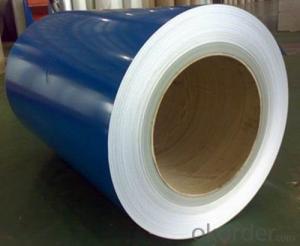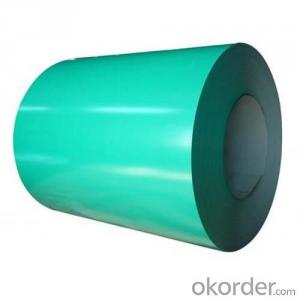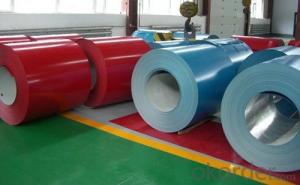PPGI for Roofing Sheet/Al-Zn Galvanized Steel Coil/PPGI in China
- Loading Port:
- Tianjin
- Payment Terms:
- TT OR LC
- Min Order Qty:
- 25 m.t.
- Supply Capability:
- 50000 m.t./month
OKorder Service Pledge
OKorder Financial Service
You Might Also Like
Item specifice
1. Application of Al-Zn Galvanized Steel Coil:
Construction, the manufacturing of cars, ships,containers and household electric appliances, other industries usage
they are mainly used in construction, light industry, automobile, agriculture, animal husbandry, fishery and commerce, etc industries.
.Manufacture anticorrosion, industrial and civil architecture roof boarding, roof grille.
.Make home appliance’s case, civil chimney, kitchen utensils, etc
.Corrosion resistant parts of cars
.Food storage, meat and aquatic products’ freezing and processing equipment etc;
.The equipments to store and transport materials, and packing implements.
2.Features of Al-Zn Galvanized Steel Coil:
1. uses hot dip galvanized steel sheet as the base material
2. zinc layer protection, dope on the zinc layer can cover and protect the steel base from corrosion
3. color coated sheet is light, beautiful and has good anti-erosion performancevanized steel coil
4.As a rich experience manufacturer, we provide quality product, competitive price and reliable after-sales service.
3.Surface Finish of Al-Zn Galvanized Steel Coil :
Surface finish | Pattern | Application |
Regular spangle | Standard spangles with flower pattern | General uses |
Small spanlge | Small spangles than regular | General painting applications |
Zero spangle | Extremely minimized spangles | Special painting applications |
4.Al-Zn Galvanized Steel Coil image:
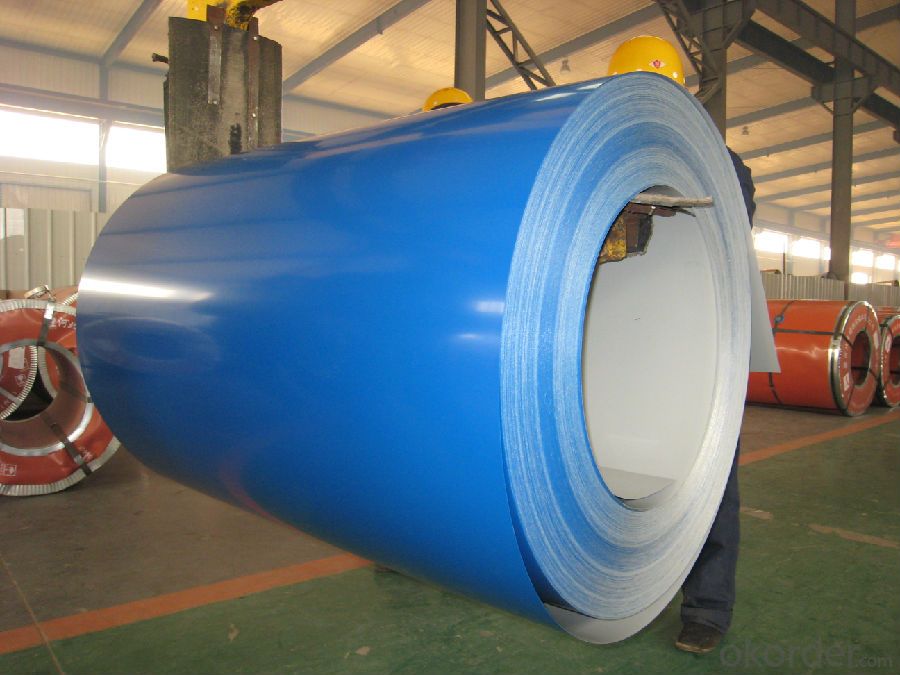

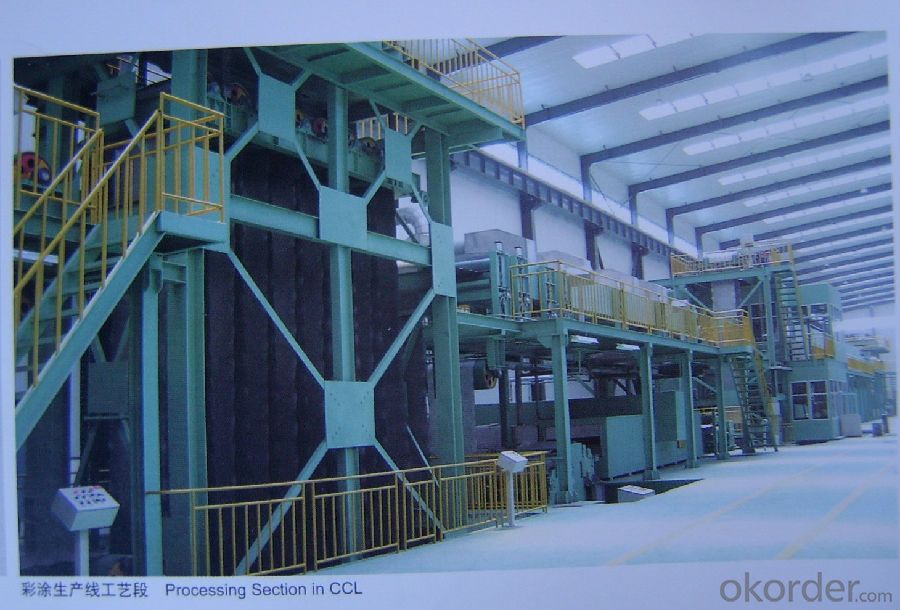
5.FAQ
We have organized several common questions for our clients,may help you sincerely:
①How about your Warranty?
Warranty: 1-Year for the whole light. Warranty is based on correct storage, installation, using and maintenanc
②How to guarantee the quality of the products?
We have established the international advanced quality management system,every link from raw material to final product we have strict quality test;We resolutely put an end to unqualified products flowing into the market. At the same time, we will provide necessary follow-up service assurance.
③How long can we receive the product after purchase?
In the purchase of product within three working days, We will arrange the factory delivery as soon as possible.
- Q:What are the common methods of forming steel coils?
- There are several common methods for forming steel coils, each with its own unique advantages and applications. The most common method is known as hot rolling. This involves heating a large steel slab to a high temperature and passing it through a series of rollers to reduce its thickness. The steel is then coiled into a large, continuous roll. Hot rolling is typically used for producing steel coils with a consistent thickness and a smooth surface finish. It is commonly used in industries such as automotive, construction, and manufacturing. Another method is cold rolling, which is similar to hot rolling but is performed at room temperature. Cold rolling involves passing the steel through a set of rollers to further reduce its thickness and improve its surface finish. This process is often used to produce steel coils with precise dimensions and excellent mechanical properties. Cold-rolled steel coils are commonly used in applications that require high strength, such as in the production of appliances, electrical components, and structural components. A third method is known as galvanizing. This involves coating the steel coil with a layer of zinc to protect it from corrosion. The steel coil is first cleaned and then immersed in a bath of molten zinc. The zinc adheres to the surface of the steel, forming a protective layer. Galvanized steel coils are widely used in outdoor applications, such as roofing, fencing, and automotive parts, due to their excellent corrosion resistance. Lastly, there is the electro-galvanizing method. This process involves applying a thin layer of zinc to the surface of the steel coil through an electroplating process. The steel coil is immersed in an electrolyte solution and an electric current is passed through it, causing the zinc to deposit onto the surface of the steel. Electro-galvanized steel coils are commonly used in industries that require a smooth and aesthetically pleasing finish, such as in the production of appliances, automotive parts, and decorative items. Overall, these common methods of forming steel coils provide a wide range of options for different applications and requirements. Whether it is hot rolling, cold rolling, galvanizing, or electro-galvanizing, each method offers unique benefits in terms of strength, durability, surface finish, and corrosion resistance.
- Q:What are the different types of steel coil cuts?
- There are several different types of steel coil cuts that are commonly used in various industries. These cuts are made during the steel manufacturing process to produce steel coils of different sizes and shapes, which can then be used for different applications. 1. Slit Coil: Slit coil is one of the most common types of steel coil cuts. In this process, a large steel coil is cut into narrower strips or slits. Slit coils are typically used for applications that require smaller widths, such as automotive parts, appliances, and construction materials. 2. Sheet Coil: Sheet coil is another type of steel coil cut that involves cutting a large coil into flat sheets. These sheets can be further processed to create different products, such as roofing materials, cladding, or fabrication components. 3. Blanked Coil: Blanking is a process in which a steel coil is cut into custom-shaped blanks. These blanks can be used for various purposes, such as forming into different parts, stamping, or machining. Blanked coils are commonly used in industries like automotive, aerospace, and manufacturing. 4. Precision Slit Coil: Precision slit coil is a specialized type of coil cut that involves cutting the steel coil with high precision and accuracy. This process ensures consistent width tolerances throughout the coil, making it suitable for applications that require precise dimensions, such as electrical components, precision tools, and automotive parts. 5. Oscillate Wound Coil: Oscillate wound coil is a unique type of steel coil cut that involves winding the steel strip in a zigzag pattern rather than a traditional flat coil. This method allows for tighter coil winding and can maximize the amount of steel on a coil. Oscillate wound coils are commonly used in industries that require high-volume production, such as stamping and roll forming. Overall, the different types of steel coil cuts cater to the specific needs of various industries, providing them with the flexibility to create products of different sizes, shapes, and dimensions.
- Q:How are steel coils used in the production of agricultural machinery?
- Steel coils are used in the production of agricultural machinery as they are a key component in the manufacturing of various parts. These coils are used to create durable and strong components such as frames, chassis, and structural supports, which are essential for the heavy-duty requirements of agricultural machinery. The steel coils are shaped, cut, and welded to create these components, ensuring the machinery can withstand the demanding conditions of farming operations.
- Q:Personally, I like Steel Cage matches to end in pinfalls. One of the biggest selling points of a Cage match is that it is to keep the competitors in and keep others out; essentially ensuring that it's a 1 on 1 match. As a result, I believe that pinfalls or submissions are important - but I know there's a lot of people that believe cage matches should only end in escape. What do you think??
- I don't really care either way. The only way I don't like it to end is when the door is opened and the person just walks out. That really isn't hard to win it like that. For last night I was hoping before the match that Bryan would win by escaping the cage. It fit his character, being a coward champ.
- Q:I'm not really sure if carbon steel is considered a metallic material.
- Steel with a lower to medium level of carbon will typically be reserved for metal sheeting for use in construction, due to its increased hardness and malleability.
- Q:I also heard Stainless holds up better againts rust, blue steel needs more care.
- Blue Steel is definitely stronger than stainless. Le Tigre and Ferrari are too. However, nothing compares to the strength of 'Blue Steel' to a non-ambi-turner.
- Q:What are the typical coil width options?
- The typical coil width options vary depending on the industry and application, but common options range from 1 inch to 72 inches or more.
- Q:What is stainless steel coil used for?
- Stainless steel coil is commonly used in various industries for manufacturing a wide range of products such as appliances, automotive parts, cookware, construction materials, and even surgical instruments. Its corrosion-resistant properties and durability make it an ideal material for these applications.
- Q:How are steel coils processed for different levels of hardness?
- Different levels of hardness can be attained in steel coils using a variety of methods. One common approach is heat treatment, in which the coils are heated to a specific temperature and then rapidly cooled to modify their microstructure and achieve the desired hardness. The heat treatment process can encompass quenching, tempering, or annealing, depending on the desired hardness level. Quenching involves quick cooling of the coils in a liquid medium like water or oil to achieve a high hardness level. On the other hand, tempering requires reheating the coils to a lower temperature and gradually cooling them to attain a desired balance between hardness and toughness. Annealing, on the other hand, involves heating the coils to a specific temperature followed by slow cooling to release internal stresses and obtain a softer and more malleable material. Additionally, mechanical processes like cold rolling or cold working can be employed to enhance the hardness of steel coils. These processes involve applying compressive forces to the coils, causing the material to deform and resulting in increased hardness. Overall, achieving different hardness levels in steel coils requires meticulous control of temperature, cooling rate, and mechanical forces to obtain the desired properties for specific applications.
- Q:What are the different methods of coil handling and storage?
- There are several different methods of coil handling and storage that are commonly used in various industries. These methods are designed to ensure the safe and efficient handling of coils, as well as their storage to prevent damage and maintain their quality. Some of the different methods include: 1. Coil cradles: Coil cradles are a popular method of handling and storing coils. They are typically designed with a U-shaped structure that provides support and stability to the coil. The cradle is placed beneath the coil, and it can be easily moved using forklifts or overhead cranes. 2. Coil cars: Coil cars are used to transport coils within a facility or from one location to another. They are equipped with special clamps or arms that securely hold the coil during transportation. Coil cars can be operated manually or automatically, depending on the size and weight of the coils. 3. Coil racks: Coil racks are storage systems that are specifically designed for storing coils in an organized manner. These racks are typically made of steel and have multiple levels or compartments to accommodate different sizes and types of coils. Coil racks can be accessed using forklifts or overhead cranes. 4. Coil turnstiles: Coil turnstiles are rotating devices that allow for easy loading and unloading of coils. They are often used in processing lines where coils need to be continuously fed into machines. The turnstile rotates the coil to the desired position, making it easier to handle and process. 5. Coil pallets: Coil pallets are specially designed pallets that are used to store and transport coils. They are typically made of steel or wood and have a unique configuration that allows for easy loading and unloading of coils using forklifts or pallet jacks. Coil pallets are often used when coils need to be transported long distances or stored in warehouses. 6. Coil storage racks: Coil storage racks are large storage systems that are specifically designed to store coils in bulk. These racks are typically made of steel and have multiple levels or compartments to accommodate a large number of coils. Coil storage racks can be accessed using forklifts or overhead cranes. These are just some of the different methods of coil handling and storage that are commonly used in various industries. The specific method used will depend on factors such as the size and weight of the coils, the available space, and the specific requirements of the industry.
1. Manufacturer Overview |
|
|---|---|
| Location | |
| Year Established | |
| Annual Output Value | |
| Main Markets | |
| Company Certifications | |
2. Manufacturer Certificates |
|
|---|---|
| a) Certification Name | |
| Range | |
| Reference | |
| Validity Period | |
3. Manufacturer Capability |
|
|---|---|
| a)Trade Capacity | |
| Nearest Port | |
| Export Percentage | |
| No.of Employees in Trade Department | |
| Language Spoken: | |
| b)Factory Information | |
| Factory Size: | |
| No. of Production Lines | |
| Contract Manufacturing | |
| Product Price Range | |
Send your message to us
PPGI for Roofing Sheet/Al-Zn Galvanized Steel Coil/PPGI in China
- Loading Port:
- Tianjin
- Payment Terms:
- TT OR LC
- Min Order Qty:
- 25 m.t.
- Supply Capability:
- 50000 m.t./month
OKorder Service Pledge
OKorder Financial Service
Similar products
New products
Hot products
Hot Searches
Related keywords
